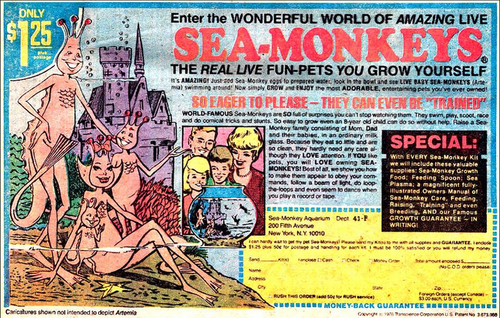
The following is an excerpt from a new Online Exclusive by Anne Valente on the commercially fraught, existentially intoxicating story of Sea Monkeys. Read the full piece on Believermag.com.
DISCUSSED: Speck, Enormous Numbers of Tiny Animals, Favorable Conditions, The Sanders Brine Shrimp Company, Green Hornet, A Distant Namesake, A Concealed Weapon, Fun and Fantasy, Peter Nero
Imagine yourself as a child. Imagine yourself lying awake at night, tucked into sheets. Imagine yourself as aware of your own smallness in the world—a speck, looking at the ceiling and its textured paint and seeing only the stars beyond it, then galaxies, then only galaxies beyond other galaxies.
Imagine infinity in your small brain, untainted by the weight of endings. Imagine your wide-awake terror as you contemplate its span.
Imagine the Midwest. A stretch of plains and trees, of ice storms and snow. A wave of hills that tumbles in a landlocked swell toward the ocean, miles upon miles of rolling cornfields that form the crest of what was once a sea. Imagine yourself a child born upon these plains, your eyes closed, in the lull of ocean waves.
Imagine infinity encapsulated in the red plastic of an aquarium, shrink-wrapped, a gift resting in the palms of your hands. Imagine unveiling it, tearing open a packet, emptying it into the aquarium upon your nightstand, pouring water over the packet’s contents, and waiting patiently. Imagine three days later, as you lie awake in the night, how infinity collapses when you roll over in your sheets, when your face draws close to the aquarium, when you squint to see life, suddenly bloomed and billowing through the water: from here, upon the Midwestern plains, the expanse of the stars and the ocean contained at last.
In 1833, frontiersman Joseph Walker mapped Utah’s Great Salt Lake. Traveling west from the central plains with 110 men, under the guidance of Captain Benjamin-Louis-Eulalie de Bonneville, a US Army officer and the leader of a westward expedition that would map central routes of the Oregon Trail, Walker was assigned the task of splitting off to explore the lake and a potential passage to California. Though Walker mapped the terrain, the salt flats he encountered took the name of his guide, as did the ancient lake from which the Great Salt Lake was formed: Lake Bonneville.
Today’s Great Salt Lake is a remnant of this prehistoric body of water, which once covered most of western Utah and parts of Idaho and Nevada. Lake Bonneville was originally a freshwater lake, spanning nearly twenty thousand miles and emptying through tributaries into the Pacific Ocean. But following a decrease in rainfall over centuries, outflow through these rivers lessened,...
You have reached your article limit
Sign up for a digital subscription and continue reading all new issues, plus our entire archives, for just $1.50/month.
Already a subscriber? Sign in




